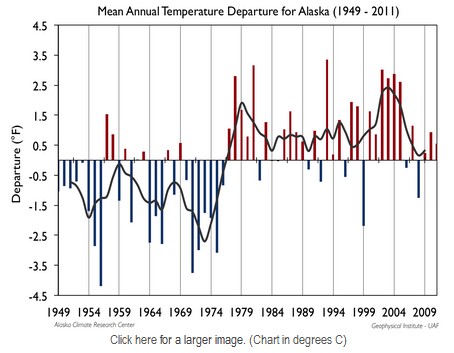A warming Arctic climate may be contributing to the declining population of guillemots.
On average Alaska has warmed by about 4 degrees Fahrenheit over the last 150 years. There are widespread consequences such as melting glaciers and insect-devastated forest in response to this temerature change. Scientists say Alaska is like a canary in a coal mine, foreshadowing the types of changes we can expect for the rest of the world.
Disappearing sea ice is one reason the Arctic is warming more than lower latitudes, because white Arctic ice normally reflects the sun’s heat into space, whereas dark, open water absorbs heat.
Scientific American Frontiers . Hot Times in Alaska. Canary in a Coal Mine | PBS
Actually, Alaska broke their all time record for sea ice this year, and all of the warming which occurred in Alaska happened at the PDO shift in 1976. Temperatures have dropped 2.5 degrees since 2005.
Considering just a linear trend can mask some important variability characteristics in the time series. The figure (above) shows clearly that this trend is non-linear: a linear trend might have been expected from the fairly steady observed increase of CO2
ANCHORAGE, Alaska — The record snowfall in Alaska’s largest city is quickly melting, leaving scores of residents to deal with winter’s lingering mean streak.
Restoration companies are getting inundated with calls from Anchorage residents reporting problems with roofs and drenched foundations.
So are insurance companies, which break the news to homeowners that problems like crawl spaces and basements with ground water seepage generally are not covered.
Those in the damage response business say they’re hearing this constant refrain from clients: “This never happens to my home!”
Well, it has this year.
“It’s pretty amazing,” said Doug Lipinski, general manager of Taylored Restoration, which has twice the fix-it business it did at this time last year. “I’ve never seen this level of workload.”
Lauren Horn is among the casualties of a season that brought more than 11 feet of snow — double the average for the city of more than 296,000.
First, a spidery crack appeared in a wall of Horn’s home. Then the next day he noticed a larger crevice just above a door, followed the next day by the door refusing to budge. The door frame was warping from the weight of some four feet of snow on the roof.
Residents of Alaska’s biggest city deal with aftermath of record seasonal snowfall | The Republic
h/t to Marc Morano



Just watch…this coming winter they will get very little snow and the media will be all over it as CAGW…..oh, hang on…this last winter was because of CAGW….can’t lose can they…
I wonder if pre 1949 temps were positive. The chart at least seems to reflect how cold the 1970s were.
This canary flutters about a lot – Arctic circle, Antarctic circle, tropical forests, Bangladesh, the upper atmosphere, and now Alaska.
I also predict that due to CAGW Alaska will get very little snow this summer.
Inquiring minds want to know:
Could record snowfalls lead to glacier growth?
Where did the heat energy come from that melts all that snow? What would that have done if the snow wasn’t there? Does that make a difference?
Do the below average sea surface temperatures in the Northern Pacific indicate a cool
summer will follow this wet winter, in Alaska?
Could the below average sea surface temperatures and above average ice area in the Bering Sea
be a factor in changing the recent rate of sea ice loss in the Chukchi and Beaufort regions during the summer?
.